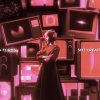Strokes Of Genius
Kourosh Beigpour Draws On 2,000 Years Of Persian Mysticism To Create Stunning Contemporary Calligraphy and Typography
May 3, 2024

A multifaceted selfie of the multitalented, LA-based Iranian calligrapher, designer and artist Kourosh Beigpour
By Aria Novosedlik
Calligraphy in Iran is held as one of the most highly esteemed forms of art. Its long and rich history predates Islam, with Persian roots that run as far back as Zoroastrianism, over 2,000 years ago. Due to the fact that Arabic calligraphy’s main original purpose has always been to communicate the word of God, the necessity for it to be as beautiful as God himself has meant that very few are considered masters of the art form.
For those of us that have no understanding of the Persian alphabet, it remains impossible to ignore the unique beauty of the culture’s scripts. Simply glancing at Persian lettering, you can’t help but imagine a deft hand moving across parchment with the grace of a pointe dancer. Each stroke is executed with such an elegant rhythmic flow. You can almost hear the inhale and exhale of the calligrapher as they carefully coordinate their breath with each finely choreographed movement. The focus is palpable; the steadiness is exquisite.
Designers long for this degree of perfection whilst understanding the discipline required to achieve it demands unwavering dedication. Kourosh Beigpour, an LA-based, Iranian born graphic designer and artist, has devoted his career to attaining it. I ran across his work while studying a few other Iranian designers, and found myself captivated by his unique ability preserve the sanctity of tradition while bringing Iranian design into the modern world. He very kindly agreed to be interviewed. Below is what he had to say.
When did you move from Tehran to LA and what prompted you to move?
My sister had been living here for about 25 years. Since she moved, I considered moving as well. I went to Malaysia to get my master's degree in 2009, which took about two and a half years. After that, I moved to the United States in 2012.

Logotype for Sarv Cultural Group
How are you adjusting to life in Los Angeles?
As an immigrant, it's a challenging question to answer. The truth is, because of the significant Iranian population abroad, especially in places like Los Angeles, adjusting to a new country happens gradually. You meet people from your homeland who share your identity and can help you through the transition. But, as we know, living in a new society has its own set of day-to-day challenges. That said, I now consider the U.S. my home, and I'm quite comfortable living here.

left: book cover for ‘Jamming’ by Farhad Babaei; right: book cover for ‘Point Zero’ by Fereshteh Mahdavipour
Are you able to make a living as a designer/artist in LA?
Since I moved to the States, working as an artist-designer has been my sole focus. I was fortunate when I arrived, as I had been working with a publication based in London. During the transition to adjust to a new society and navigate all the changes that come with being an immigrant, that job provided significant stability. It made a big difference in helping me settle into my new life.

Typeface design ‘Qasida’, named after a pre-Islamic form of elegiac poetry
What are your biggest challenges there?
Apart from the challenges we all face as human beings, no matter where we live, it's sometimes very difficult to be far from the friends and family I grew up with. As an artist, I have a deep connection with the architecture, music, places, and even the trees and nature of Iran. I miss the mountains a lot. Those connections, which tie me to the core of Iranian art and nature, are the things I often find myself missing, and it's really challenging.

left: poster for book signing of ‘A Narrative of Endurance’, by Homa Sarshar; right: poster for Exhibition of posters by Beigpour on the subject of Shakespeare’s tragedies
When did you start doing Calligraphy?
I started practicing calligraphy when I was a kid, back in middle school. My grandfather on my father's side was a famous architect, specializing in traditional Iranian architecture, and he was known for his beautiful handwriting. Because of his personality and the impact he had on our family and culture, I took a class to improve my handwriting. As I became more familiar with the art, I enrolled in an art school and became interested in typography. I gradually began taking calligraphy classes to improve my skills, and even today, when I meet a master calligrapher, I seek out their expertise to learn new techniques. I watch videos and practice daily. I have two different approaches: one is dedicated to skill development, and the other is purely for the enjoyment of the art. Both are processes I truly love.

Logotype for Iranian musical group Ebtekar
Did you study under a master? If so, how long did your training take?
I've studied under a few calligraphy masters, but I don't consider myself a professional calligrapher. My approach to calligraphy is more about understanding the shapes of letters, their behavior, and the techniques I need to apply to my art. Overall, I've taken calligraphy classes on and off for about five or six years.

Left: book cover for ‘Suddenly’ by Abbas Nalbandian; right: book cover for ‘Witness’ by Mansour Koushan. Both pieces demonstrate Beigpour’s ability to stretch the expressive power of Persian calligraphy
Do you still have family in Iran? How have they been affected by the protests last year?
Yes, aside from my immediate family, all my cousins and relatives from both my father's and mother's sides live in Iran, in Tehran and Kermanshah, where I grew up. I believe that the protests from last year have deeply affected every Iranian who has faced, or is facing, challenges with the government. As an Iranian living abroad, it has impacted me significantly because I am deeply concerned about the people in Iran—my family, my culture—and the daily struggles they endure.

Typography for CD cover: ‘Blue Flowers’ by Marjan Farsad, demonstrating Beigpour’s interpretative range
Do you feel like the political situation affects you even though you are in LA?
Oh, yes, of course. It affects every Iranian, no matter where you live. In some ways, it can be even harder for those of us living abroad. For example, during the protests, when I talked with friends back in Iran, I could sense the challenges they were facing. But despite these difficulties, they still had to continue with their lives—attending protests during the day and gatherings at night. The problem is, our primary source of information comes from the media, and often, we only see the bad news about what's happening in the country. This makes it even harder for us, emotionally and mentally.

left: poster for ‘The Art of Improvisation’ by Tār and Kamāncheh Misaq and Matin Eshaghi; right: poster for book signing and poetry reading by Sheida Mohamadi /Jordan Center for Persian Studies. The rhythms of Arabic music are echoed by the fluidity of Persian calligraphy
Do you have friends in Iran that are designers? How is it working in Iran as a designer? Do you feel free to express yourself when working there?
Absolutely. I went to art university, and most of the people I know are artists, or they work in cultural fields like directing, theater, or acting. The challenge here is that there are different considerations when it comes to expressing yourself as an artist in Iran. Yes, you can express yourself as a designer, but you never know when it might become problematic.
In Iranian culture and the arts, when you work with independent artists, there's usually not much money involved or at least it used to be. You have to choose between working as an independent artist, expressing yourself freely but earning less, or working with the government to ensure a stable income. This creates a difficult dilemma for artists in Iran, forcing them to decide between financial security and artistic freedom.

Logotype for ‘'Cinema Verite’, the Second Iran International Documentary Film Festival.
You did an interview where you spoke a lot about the connection between mysticism and calligraphy. Can you talk a little bit more about that?
To address these questions, I'd have to delve into history and culture, but I'll try to keep it as clear and concise as possible. The point is that since Islam became the dominant force in Iran about 1,400 years ago, the country has undergone significant changes. Iranians have combined their pre-Islamic culture with Islamic influences, resulting in a unique blend that you don't typically find in other Islamic countries. This combination has led to a distinct cultural identity for Iranians.

left: book cover for ‘Iran, Iranian and We’ by Mansour Koushan; right: book cover design for ‘Rewriting the Account of Shafa' by Akbar Sardouzami. Here Beigpour successfully explores layering and dimensionality
In this context, mysticism has had a profound impact on various aspects of Iranian art, including architecture, music, painting, and, of course, calligraphy. These elements are deeply intertwined, and mysticism has played a key role in shaping the Iranian artistic landscape. Calligraphy, in particular, is not isolated from other art forms; instead, it is part of the broader cultural tapestry that defines Iran's unique artistic tradition.

Calligraphy for book cover ‘Dear Aziz’ by Keyomars Marzban. The use of the brush almost feels more Japanese than Persian
You spoke about how the word is with God and the word IS God. Do you feel that words are consciousness?
In my view, everything in the universe, regardless of its form, has consciousness and serves a certain purpose in whatever shape it takes. I borrowed this concept and applied it to my artwork, drawing inspiration from Fazle Astarabadi, the founder of the Hurufism movement, which dates back almost 700 years in Iran.
We are all familiar with the famous quote from the Gospel, 'In the beginning was the Word, and the Word was with God, and the Word was God.' Historical documents indicate that Fazle Astarabadi was familiar with the Torah and the Gospels, and he borrowed and combined different ideas to create his doctrine. This quote relates to that concept.

left: poster for Persian poetry recital; right: Doornavazi music festival poster for Iranian Students of California
In his doctrine, Fazle Astarabadi believed that everything in the universe has some form of communication with a divine being, and the most advanced form of this communication is through human speech. Speech consists of letters, and based on this idea, he ascribed a certain value to letters, suggesting that consciousness is part of this value."

Logotype for exhibition ‘Iranzamin’ (Land of the Persians) at Sydney’s Powerhouse Museum
Do you consider calligraphy to be a form of meditation?
Yes. I think any kind of art that requires attention, makes you hold your breath, and demands focus and precise adjustments, can be considered a form of meditation.
Because calligraphy is sacred, is it controversial to design type that is modern or different from what is traditional Persian script?
It all depends on your belief. If you view it as sacred, then you'll unconsciously bring that sense of sacredness into your work. But if you don't, working with calligraphy or type design might be more about focusing on the graphic elements and the shapes of the letters. I do believe that when we're working on a script or calligraphy style with a certificate or traditional background, it's important to delve into the history behind those scripts. By familiarizing ourselves with their histories, we can create better work. Understanding the nature of these specific scripts can also help us create new and innovative pieces.

left: book cover for ‘A Story of Destiny’ by Mahmud Farjami; right: book cover for ‘The infernal days of Aqa-Ye Ayaz’ by Reza Baraheni. Visual puns work in Arabic too, it seems.
……………………………………………………………………………………………………………………………………………………
What do you mean when you speak about Fazl and the idea of a connection between numbers and words?
In his doctrine, Fazle Astarabadi assigns a specific numerical value to each letter. For example, the letter Alef is assigned the number 1, the letter Beh is 2, and so on for all Arabic and Farsi letterforms. This system is based on the Abjad method, and Fazle borrowed some of his ideas from Kabbalah in Judaism. He aimed to decode the underlying meaning of each word by determining the numerical value of the letters.

Logotype for ‘The Companions'. To a non-Arabic speaker, these forms almost read pictorially: are those humans on the left-hand side?
For instance, let's say the numerical value of my name is 20, and the value for the word 'winter' is also 20. If I happen that I was born in winter, therefore there is certain connection between me and winter. By decoding the numerical values of words, he intended to reveal hidden connections and meanings in the world around him.
Who are some of your influences?
I often find inspiration from a variety of sources—whether it's modern painters, sculptors, musicians, architects, or anyone whose work resonates with me. These connections help me channel ideas and fill gaps in my own artistic process. When I'm working on a piece, encountering these influences can spark new ideas or provide insights that guide my creativity.

Typography for book cover ‘My brother was a wizard’ by Akbar Sardouzami. There are seemingly no limits to the artist’s stylistic range.
What inspires your work?
More than anything else, I am drawn to mysticism, which has been a significant focus for me over the past few years. Reading and practicing mysticism and Dervish order is a daily practice to me, and I often find ideas within it that I can transform into visual art. I take these concepts, work with them, and develop them to create new pieces.

left: book cover for ‘A Night at Maryam's House’ by Mansour Koushan; right: book cover for ‘Speech and the Colours of Imagination’ by Ashkan Avishan
What is your process?
I come across an idea or something that catches my attention, and when that happens, I do research to understand its history and explore every aspect of it. During this process, I take notes, sketch, and doodle. These activities, which I do while exploring the concept, often become the seeds that I use later to create my artwork.

Typography for Book Cover ‘The Victims’ by Mansour Koushan. Frighteningly expressive.
Is there anything that you’ve been dying to create? Any upcoming exhibits? Any ideas or messages that you feel you need to communicate in your future work?
After my last solo exhibition at Advocartsy Gallery in Los Angeles, I was reading about mysticism as always and came across an intriguing concept. Since then, I've been developing new visual art based on that concept. I hope to have another solo exhibition next year or the year after, though I'm not sure. I'd love to create a video or some kind of installation centered on this idea. In the future, I aim to create multimedia work that combines different art forms. I'm excited about the possibilities and hope to bring these ideas to life."

This image from Beigpour’s current exhibit, ‘Mandal’, demonstrate the designer’s unbridled calligraphic mastery
We’ve looked at many examples of your work. Which is most important to you?
Right now, my most significant project is my latest exhibition, called 'Mandal.' I've been creating art for the past 20 years, and when I look back, I might not find all of my previous pieces as interesting. However, the truth is that every piece I've worked on, every project I've undertaken, whether I like them or not, has been part of the process that has shaped me into the person I am today. Each project, regardless of the concept or format, has been part of my learning journey. The 'Mandal' project is, by far, the most important one to me.
Aria Novosedlik is a Toronto based designer, writer and researcher







